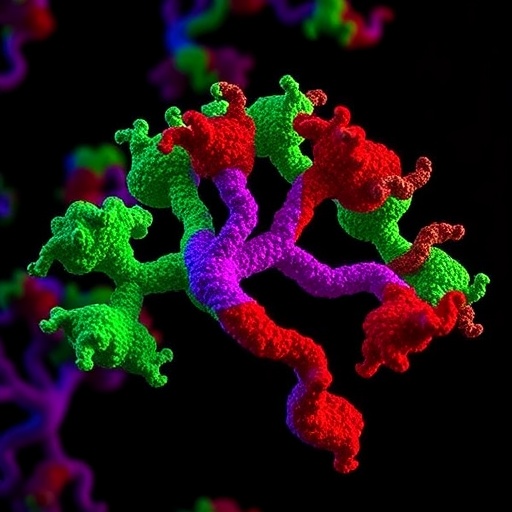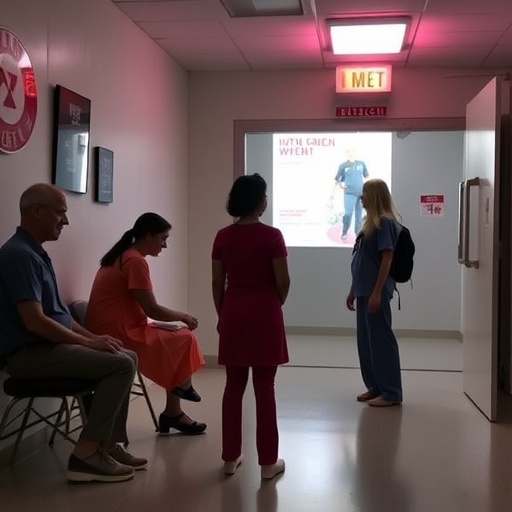In an exciting breakthrough in cancer therapy, researchers have made significant strides in enhancing treatment efficacy through the introduction of a novel multivalent fusion protein. This innovative biopharmaceutical has been meticulously engineered to target two critical receptors involved in cancer progression: the Vascular Endothelial Growth Factor Receptor 2 (VEGFR2) and the Death Receptor 5 (DR5). The compelling study, led by leading scientists, including I.N. Druzhkova and A.G. Orlova, provides a comprehensive evaluation of the antiangiogenic and antitumor effects of this fusion protein using advanced multimodal microangiography techniques. The implications of this research could herald a transformative shift in how we approach cancer treatment.
The VEGFR2 receptor plays a pivotal role in angiogenesis, the process through which new blood vessels form from existing vessels. This process is crucial for tumor growth and metastasis, as the development of a robust blood supply is often a prerequisite for tumors to thrive and expand. By inhibiting this receptor with the newly developed fusion protein, researchers aim to disrupt the blood supply to tumors, effectively starving them of the necessary oxygen and nutrients they require for survival and growth.
On the other hand, DR5 is a crucial player in apoptosis, the programmed cell death mechanism that can be harnessed to eliminate cancer cells. The fusion protein’s ability to target this receptor opens a promising avenue for enhancing the sensitivity of cancer cells to treatments that induce cell death, providing a dual attack strategy against tumors. This dual targeting aspect is the cornerstone of the researchers’ hypothesis that combining strategies can yield more potent therapeutic outcomes than traditional single-target approaches.
Utilizing multimodal microangiography, the study assessed the physiological impact of the fusion protein in a preclinical model. This imaging technique allowed for real-time visualization of microvascular changes and provided invaluable data on tumor perfusion and vascular integrity before and after the administration of the treatment. This method not only enhances the understanding of treatment effects but also aids in the early detection of therapeutic success or potential resistance.
Upon administration of the fusion protein, significant reductions in tumor volume were recorded. The data illustrated that not only did the multivalent protein incapacitate blood vessel formation, but it also initiated substantial apoptosis across various cancer cell lines tested. This combination of effects resulted in a marked improvement in survival rates for the treated subjects in the study.
The implications of these findings extend beyond the laboratory. By advancing our understanding of the complex interactions between cancer biology and therapeutic mechanisms, this study paves the way for developing more effective treatments tailored to individual patient profiles. As researchers refine this fusion protein, the potential for clinical application in human patients becomes increasingly tangible.
Moreover, the careful design of the multivalent fusion protein raises the bar for future drug development. Incorporating dual targeting systems may become a new standard in cancer therapeutics, leading to drugs that can attack tumors from multiple angles simultaneously. This paradigm shift holds promise not only for oncology but can extend to other fields where targeted therapies are crucial.
The work of Druzhkova, Orlova, Fedulova, and their team underscores the importance of collaboration in scientific research. The expertise of each author contributed to the innovative approach taken towards the development of the fusion protein, highlighting the role of multidisciplinary teams in pushing the boundaries of what is possible in medical science.
In addition to the compelling clinical implications, the detailed technical aspects of the study provide a rich source of knowledge for future researchers. The methods employed in assessing the fusion protein’s efficacy, including the elaborate protocols for multimodal microangiography, offer a framework that other scientists can build upon. This emphasis on sharing methodological insights is essential for fostering innovation and accelerating progress in the field.
As with any groundbreaking study, it is essential to approach the findings with a degree of cautious optimism. While the preclinical results are promising, further studies, including clinical trials, are required to ascertain the safety and efficacy of this multivalent fusion protein in humans. Regulatory processes will need to be navigated carefully to ensure that the advancements achieved in the laboratory translate effectively into patient care.
Peer-reviewed articles such as this one are critical for the scientific community as they catalyze discussions on new therapeutic avenues. As this research gains attention, it may inspire a new wave of studies investigating similar dual-targeting strategies, potentially leading to a renaissance in cancer treatment methodologies currently in use. Furthermore, the symbiotic relationship between research and clinical practice highlights the importance of continual exploration within the field.
In conclusion, the groundbreaking study on the multivalent fusion protein targeting VEGFR2 and DR5 represents a hopeful advancement in the ongoing battle against cancer. By demonstrating the potential of a dual-targeting approach and utilizing cutting-edge imaging technologies, this research not only contributes to scientific knowledge but also carries the promise of innovative therapies that could provide new hope for patients facing this devastating disease. As we look forward to the potential of these findings to influence future treatments, the excitement within the scientific community is palpable.
The relentless pursuit of effective cancer treatments remains a hallmark of modern medicine. As scientists continue to unravel the complexities of tumor biology and develop novel therapeutic strategies, studies like those conducted by Druzhkova and colleagues serve as beacons of hope, illuminating the path toward more effective, personalized treatment options for cancer patients worldwide.
Subject of Research: Multivalent fusion protein targeting VEGFR2 and DR5 in cancer therapy.
Article Title: Multivalent fusion protein targeting VEGFR2 and DR5 receptors: assessing the antiangiogenic and antitumor effects via multimodal microangiography.
Article References:
Druzhkova, I.N., Orlova, A.G., Fedulova, A.S. et al. Multivalent fusion protein targeting VEGFR2 and DR5 receptors: assessing the antiangiogenic and antitumor effects via multimodal microangiography. J Transl Med 23, 949 (2025). https://doi.org/10.1186/s12967-025-06859-8
Image Credits: AI Generated
DOI: 10.1186/s12967-025-06859-8
Keywords: multivalent fusion protein, VEGFR2, DR5, antiangiogenic, antitumor, multimodal microangiography, cancer therapy, apoptosis, therapeutic efficacy.
Tags: advanced cancer research findingsantiangiogenic cancer therapyapoptosis induction in tumorsblood supply disruption in tumorscancer treatment breakthroughsDeath Receptor 5 roledual-target fusion proteininnovative biopharmaceutical developmentmultimodal microangiography techniquesmultivalent fusion protein engineeringtumor growth suppressionVEGFR2 inhibition





